�Performance
A friend saw me using the Pixel and asked if he could give it a try. After admiring the design and hardware he opened it up and said, “But this is basically just an iPad with a keyboard, right?” I didn’t know how to answer the question. I’d never considered the comparison, indeed I didn’t even think to include the iPad 4 as a point of reference in this review. How is the Pixel like an iPad? It took me a while to process, but I think what my friend was getting at is that the Pixel is primarily for consumption, in the same way as the iPad. Different approaches to the future of computing, with the same pitfalls. I got the same feeling from reading Anand’s Surface Pro review. Microsoft is so convinced that this hybrid strategy is the way to go, but in their case the hardware falls short, providing an imperfect tablet and notebook experience. Meanwhile, the aforementioned iPad has excellent tablet hardware and software, but trying to get work done on one is mostly folly; chock it up to a form factor that doesn’t hold up for lots of typing and a UI that’s better suited to the unitasking of media consumption than the multitasking of even the full GMail/GTalk website.

Chrome OS, as Google’s foray into the future of computing, suffered from some pretty modest hardware. Yet in real terms, even the lowly Atom Chromebooks outpaced the silicon found in even the iPad 4. But faster silicon and a speedy browser never seemed quite good enough. And that’s where the Pixel comes in. With the Pixel we’re looking at what is honestly pretty humble silicon, nearly identical to the processor in the 13” MacBook Air. What you get, though, is performance that rivals the better endowed 13” Retina MacBook Pro.
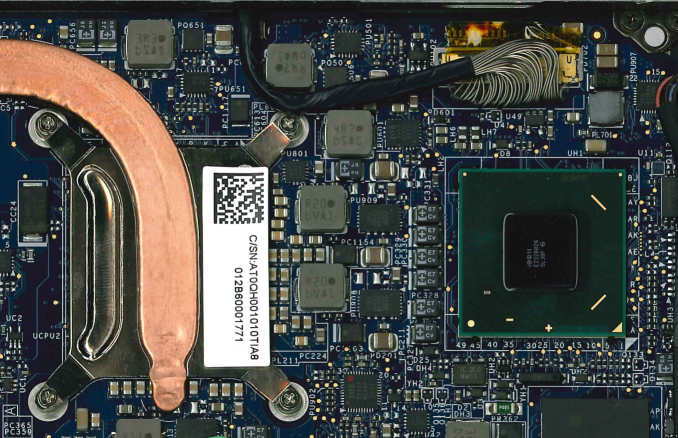
Pixel's Intel Core i5-3337U SoC (under cover)and HM75 Chipset
As always, the Chromebook test suite is something of a grab bag from several categories. Our tablet tests get good representation here, alongside some tests we’ve been incorporating for Surface reviews. As hard as it is to benchmark on Android, it’s much worse on Chrome OS.
We start with our Javascript tests, including our age old friend, Sunspider. This test is so long in the tooth that we’re on the verge of seeing two digit test times. The test gives us a good idea of how far apart the lowest players in compute are versus the highest, and that’s without including any top of the line devices. Within a given performance category, though, the differences become small.
If you just wanted to establish that the Pixel belonged in a class apart from the history of Chromebooks, and tablets for that matter, this is it. The Pixel’s performance here is close enough to the the rMBP as to consider it a draw, though the Surface Pro in IE seems to beat both soundly. This is something of a cake walk for this caliber of hardware, so let’s look at something a bit more demanding.
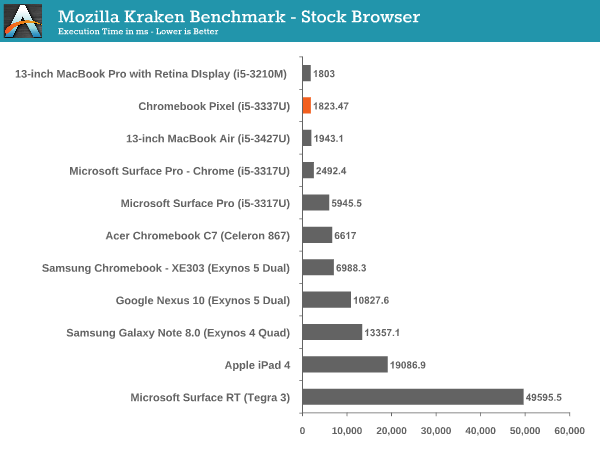
Mozilla Kraken is the next iteration in Javascript tests, with a much more strenuous workload, though it is already rapidly approaching sub-1,000 ms scores. Against the Surface Pro, the Pixel comes out way ahead here, even with the field leveled by running Chrome as the browser. There’s a clock difference of just 100 MHz between the Pro and the Pixel, not nearly enough to account for the difference in performance. This may be a situation where the Chrome OS conceit bears fruit; by eliminating the cruft of other operating systems, more resources can be devoted to the task at hand. Once again, the Pixel and the rMBP sit neck and neck with each other, despite a 15% maximum clock advantage in the rMBP’s favor. The rest of the pack? An order of magnitude behind.
Kraken and Sunspider don’t make for terribly well-rounded tests; what we want is something that can tax CPU, memory, and even GPU and local storage. For something approaching that we’ve added WebXPRT from Principled Technologies. The test actually simulates real world web applications and should give us a better idea of how the different platforms stack up when viewed from a wide angle lens.
The rMBP has a definite edge over the Pixel here, showing a chink in the armor. We haven’t explored WebXPRT enough to say for certain what components are being exposed in each subtest. It’s possible that memory limitations played a role, or the clock advantage in the rMBP just needs a longer test to have its value exposed. Regardless, the test does still make clear that in this group, the Surface Pro, Pixel and rMBP are alone at the top, and the Surface Pro is just barely hanging on.
WebGL is a developer tool that’s quickly gaining popularity, though it remains mainly the stuff of tech demos. If gaming is to be a serious component of the web as a platform, then a robust API must exist and supported hardware must perform adequately. When the Acer C7 Chromebook crossed our path we were impressed with Intel’s HD 2000 graphic’s ability to outperform the Atom offerings and even Samsung’s Mali GPU. Now we have HD 4000, in a few iterations. Testing WebGL capabilities is not the easiest affair, despite the number of tech demos, but we chose a few and measured up our players.
These results go a long way to demonstrating how challenging it is to compare such disparate platforms. Though the rMBP and Pixel both use Intel’s HD 4000 graphics, they’re each configured slightly different. The rMBP has the base clock advantage (650Mhz to the Pixel’s 350MHz), but each has the same maximum frequency (1.1GHz). That max is theoretical, tough and the reality of notebook design is that device thermal characteristics will weigh heavily on whether that maximum is achieved, and for how long it might be sustained. There’s also the fact that these devices run drastically different operating systems, and so these tests become more about how their respective platforms handle WebGL given roughly similar hardware. The loose results shine very positively on Chrome OS, less so on Chrome on OS X.
The WebGL aquarium test was particularly anomalous, with the Pixel hitting v-sync even after raising the number of visible fish to 1,000. Again, these tests don’t establish a firm graphics performance advantage for the Pixel, but simply look at the ability to render WebGL graphics. There is a direct relationship with the Pixel and the Chromebooks that preceded it and here we can say with certainty that the advantage goes to the newcomer. Anand described in his review of the Samsung Chromebook (XE303) having to watch even simple games stutter and drop frames. The same remained true in the Acer C7. The Pixel removes that concern, and establishes a performance watershed for WebGL; WebGL developers that want to what platform puts their best foot forward need look no further.
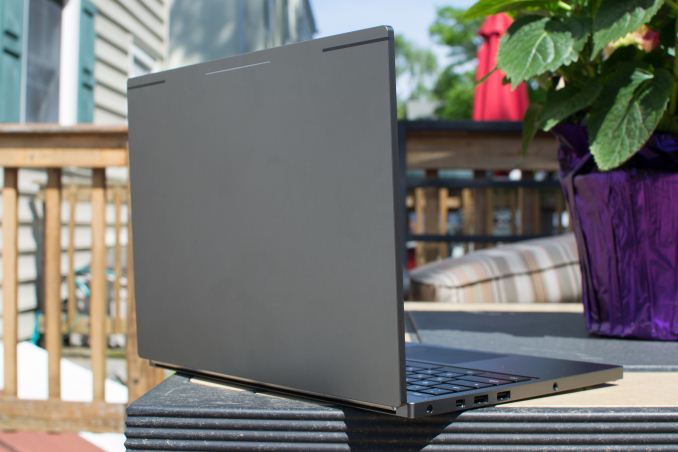
After all that, though, there’s a certain subjective reality that we must discuss. Even owners of workstation class PC’s have experienced poor performance in their browser. Web sites are increasingly complex, able to generate multiple threads within themselves and consuming impressive amounts of resources. And even when there’s not much going, perhaps a few display ads on a long column of text with images interspersed, you can still encounter stutter and hesitation as you scroll through the page. Or there’s a long delay after triggering an action in a web app, before seeing the appropriate reaction. The culprit could be network in nature. It could be related to the app itself. Or it could be, that a background process needed those compute cycles for a bit, before relinquishing them to complete your task. Chrome OS removes that confound, while also working to mitigate network delays. And the result is palpable. Even in Gmail, derided for some time now for its laggy performance, feels fluid and responsive. Playing a simple 2D canvas game could be an exercise in frustration in the C7 or even my MBP, but in the Pixel you never perceive anything but v-sync. There’s something to this experience that can’t quite be measured with the tools we have, but it’s there, and it’s really nice.
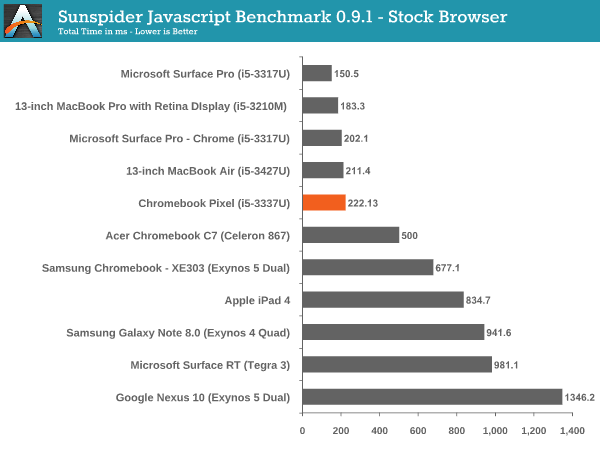

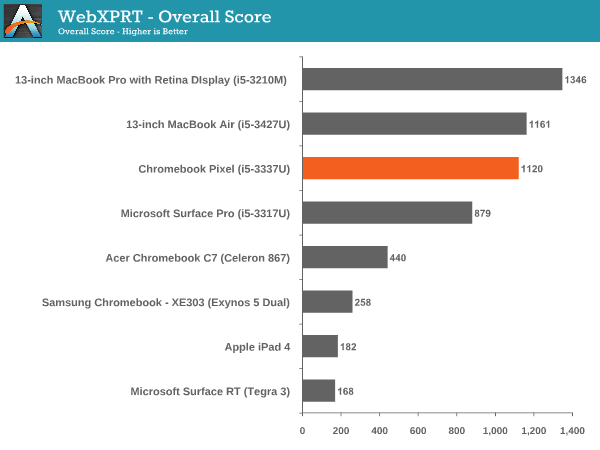


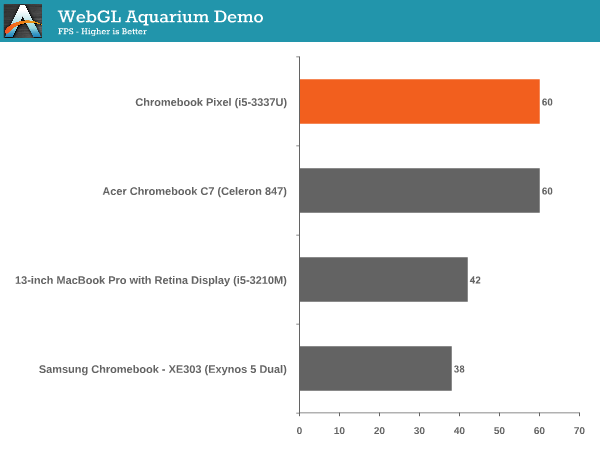












74 Comments
View All Comments
karasaj - Friday, May 31, 2013 - link
What other objectivity can you have than display analysis, battery life, build quality (even still moderately subjective), and performance? Heat and noise I guess, which is normally included in laptop reviews, but considering he can't actually run HWmonitor, and it's also probably hard to actually load up the machine with a super heavy workload, there's not much he left out.If you don't like the subjective parts, skip them. Subjective qualities at the expense of objectivity can be bad, but he hasn't sacrificed that really.
nunomoreira10 - Friday, May 31, 2013 - link
Those color (target and actual) diagrams are great!Please do so again on future displays reviews
frakkel - Friday, May 31, 2013 - link
Finally - Someone who understands that we are not using our notebooks for watching 16:9 movies day long. To see a more square format is very much welcome. Now I will just wait for Haswell and then I will buy.internetf1fan - Saturday, June 1, 2013 - link
Wider screens are better for productivity as you can fit multiple documents side by side. Going back to 4:3 displays really hurts how I work because of lack of space.leexgx - Saturday, June 1, 2013 - link
we are not talking going back to 4:3 that would be silly, we are talking about website friendly 16:10 screensnot many people use the side by side feature in windows 7
seapeople - Monday, June 3, 2013 - link
Not many people use graphics cards, either, so why not just get rid of all those?twtech - Friday, May 31, 2013 - link
Remember the dot-com boom of the '90s, when the internet was supposed to take over everything? And then it didn't, and all these startups went bust, but it still had a significant impact, which continues to grow today?Right now, people are saying, the PC is dead, tablets are the new king. We've heard this mantra before. Notebooks, netbooks, consoles vs. PC gaming, everything new was supposed to kill the desktop PC. And along the way, those things have taken some marketshare when those devices were actually the more appropriate tool for the job.
If all you had was a hammer and nails, but now you have a screwdriver and screws as well, some of the times when you previously used nails, now you'll use screws instead. If you put the usage of nails on a chart, maybe you'd say that they were "dying", and that usage of screws is the future, since of course it was growing from zero. Well, we know that both types of fasteners have their preferred uses. And tablets may replace PCs for certain uses - the use cases in which they are genuinely better. But there would be no sense in trying to use a tablet for things the PC is naturally better at.
Crono - Friday, May 31, 2013 - link
The PC isn't dead. We're just in a transition period where tablets are becoming a very popular form factor of PCs. Anyone who wants to create content knows that a base iPad isn;t going to do you much good unless you have the right apps and preferably a physical keyboard. That's why the Surface and Surface Pro are the right direction, I think, though everyone agrees Haswell is needed to bring better battery life. Hybrid and convertible tablets or ultrabooks - whether they are Android, Windows, or iOS - will be key for the next few years... until we start getting scrolls. ;)Personally, I would love a 10" x 12" x 0.2" OLED flexible scroll computer with a display that can become rigid when completely unfurled from a thin computer core/column.
rwei - Friday, May 31, 2013 - link
Odd that you yourself note the unfavorable comparison to the 13" rMBP, yet your review gushes with enthusiasm for the Pixel. I love shiny, beautiful new gadgets as much as or more than the next guy, but your praise seems excessive.I more or less took away from this is that the Pixel is cool because it makes for a really nice and shiny typewriter, and wow look it's evolving really quickly to the point where it's slowly approaching the level of basic functionality that other systems already deliver.
Arbie - Saturday, June 1, 2013 - link
rwei - I agree with you completely.And there is a weird parallel between the design effort put into this overdone $1400 browser box and the writing effort put into this overblown, wordy, and just so artfully crafted treatise on it. Is this all a joke of some kind? I got through a couple of pages and couldn't take it any more. If you gave the author an enema he could fit in a shoebox.
As for the computer, the only thing it's ideal for is to make the Surface RT look like a success. Maybe it makes sense as an investment collectible, considering that they're only going to sell two or three. Nothing worthwhile here.